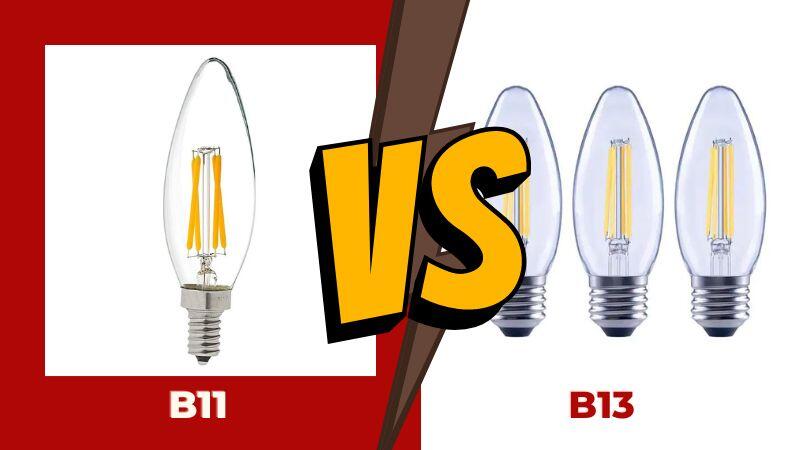When it comes to incandescent light bulbs, B11 and B13 bulbs are two commonly used types that can be found in a variety of household lighting fixtures. While they may appear similar in size and shape, there are some notable differences between the two that can impact their performance and effectiveness in different environments. In this article, we will compare B11 and B13 bulbs in terms of their size, brightness, color temperature, color rendering, energy efficiency, and lifespan, to help you determine which one is the best fit for your lighting needs.
Differences Between B11 and B13 Bulbs
Size and Shape
The main difference between B11 and B13 bulbs is their size and shape. The B11 bulb has a diameter of 1.375 inches and a length of 3.75 inches, while the B13 bulb has a diameter of 1.625 inches and a length of 3.75 inches. This means that the B13 bulb is slightly larger in size and may not fit into certain fixtures that are designed specifically for B11 bulbs.
Check Also – B13 Vs B14 Bulbs: What Are The Differences?
Brightness and Lumen Output
When it comes to brightness and lumen output, the B13 bulb typically has a higher wattage and lumen output than the B11 bulb. The B11 bulb typically has a wattage range of 25-40 watts and a lumen output of 200-300 lumens, while the B13 bulb typically has a wattage range of 40-60 watts and a lumen output of 370-500 lumens. This means that the B13 bulb is brighter than the B11 bulb and is better suited for areas where you need more light, such as a kitchen or a workspace. The B11 bulb, on the other hand, is ideal for creating a soft, ambient light in areas like a bedroom or a living room.
Color Temperature and Color Rendering Index
The color temperature and color rendering index (CRI) of a bulb can also impact its performance and effectiveness. The color temperature of a bulb is measured in Kelvin (K) and refers to the color of the light it emits. The higher the Kelvin rating, the cooler and bluer the light will appear. The lower the Kelvin rating, the warmer and more yellow the light will appear. The B11 bulb typically has a color temperature of 2700K, which is a warm, yellowish light that is similar to the light emitted by traditional incandescent bulbs. The B13 bulb, on the other hand, typically has a color temperature of 2900K, which is a slightly cooler, more neutral light.
The CRI of a bulb measures how accurately it can render colors compared to natural daylight. The higher the CRI, the more accurately the bulb can render colors. The B11 bulb typically has a CRI of 100, which is the highest possible rating, while the B13 bulb typically has a CRI of 90, which is still considered a good rating. This means that the B11 bulb is better at accurately rendering colors and is ideal for areas where color accuracy is important, such as an art studio or a makeup vanity.
Energy Efficiency and Lifespan
When it comes to energy efficiency and lifespan, both B11 and B13 bulbs are incandescent and are not as energy-efficient as other types of bulbs like LED or CFL. The B11 bulb typically has an energy efficiency rating of 6 lumens per watt and a lifespan of 1,000 hours, while the B13 bulb typically has an energy efficiency rating of 10 lumens per watt and a lifespan of 1,000 hours. This means that the B13 bulb is slightly more energy-efficient and has a shorter lifespan than the B11 bulb.
Conclusion
B11 and B13 bulbs are commonly used incandescent light bulbs that have their own unique characteristics and strengths. While the B11 bulb is smaller in size and has a lower wattage and lumen output, it has a warmer color temperature and a higher CRI, making it ideal for creating a soft, ambient light in areas like a bedroom or a living room. On the other hand, the B13 bulb is larger in size and has a higher wattage and lumen output, a cooler color temperature, and a slightly lower CRI, making it ideal for areas where you need more light and color accuracy is not as important.
It’s important to consider your specific lighting needs and preferences when choosing between B11 and B13 bulbs. Factors like brightness, color temperature, color rendering, energy efficiency, and lifespan should all be taken into account. If you’re looking for a warm, cozy atmosphere, the B11 bulb may be the better choice. If you need more light or color accuracy is important, the B13 bulb may be the better choice.
It’s also important to note that incandescent bulbs are not as energy-efficient as other types of bulbs like LED or CFL. If energy efficiency is a concern, you may want to consider switching to a more energy-efficient option. Additionally, both B11 and B13 bulbs have a relatively short lifespan, so you may need to replace them more frequently than other types of bulbs.
In summary, the choice between B11 and B13 bulbs ultimately comes down to your specific lighting needs and preferences. By considering factors like brightness, color temperature, color rendering, energy efficiency, and lifespan, you can choose the right bulb for your lighting fixture that will provide the ideal amount and quality of light for your space.




